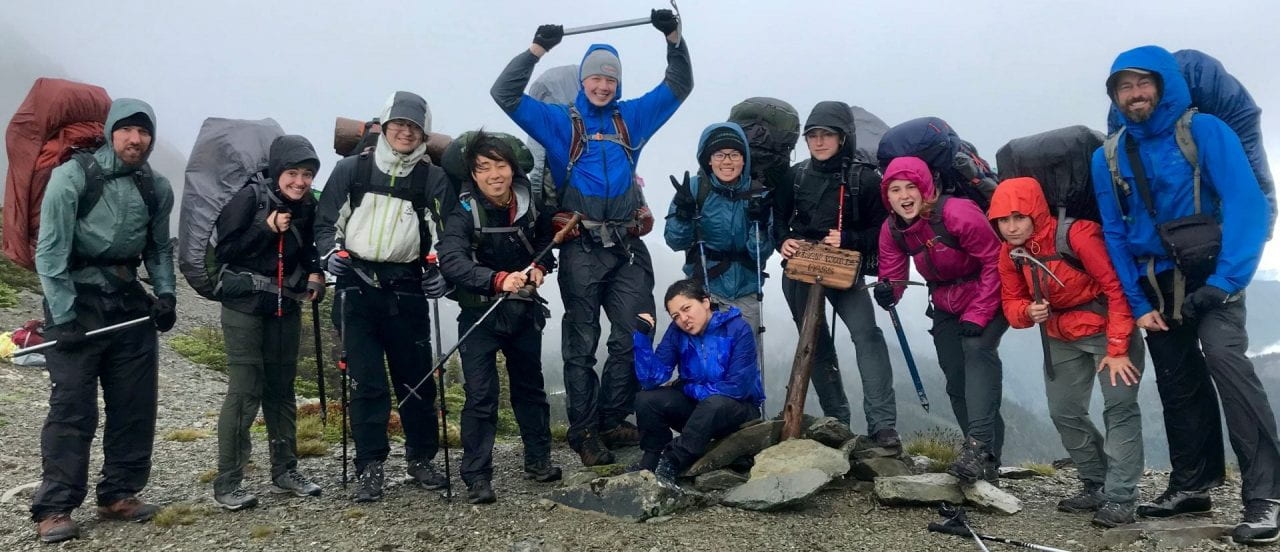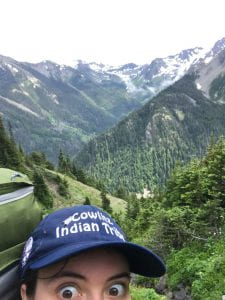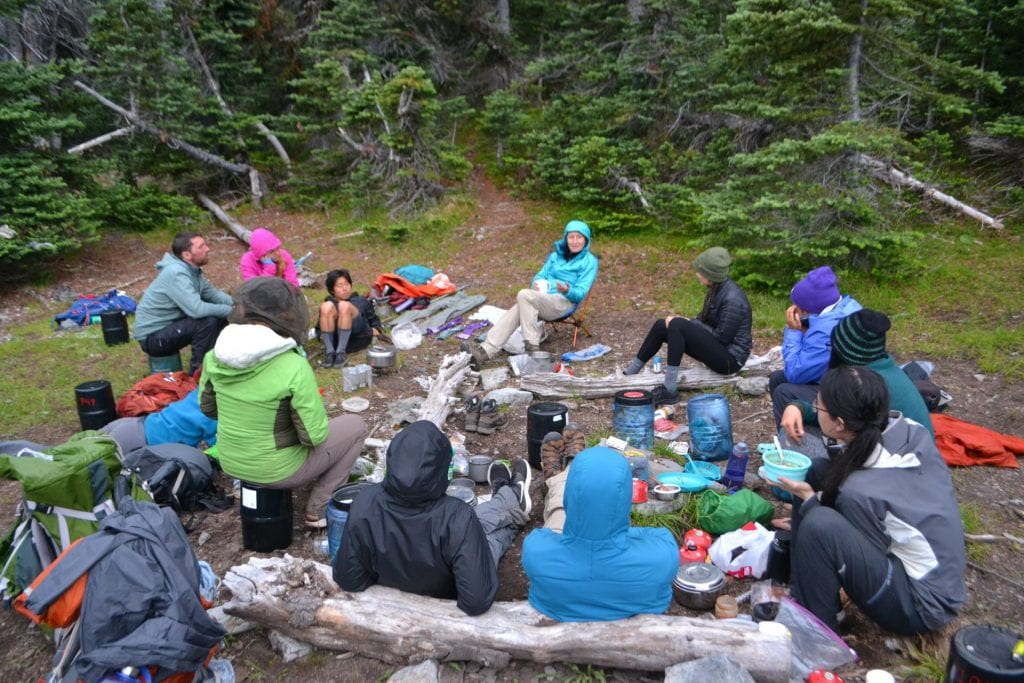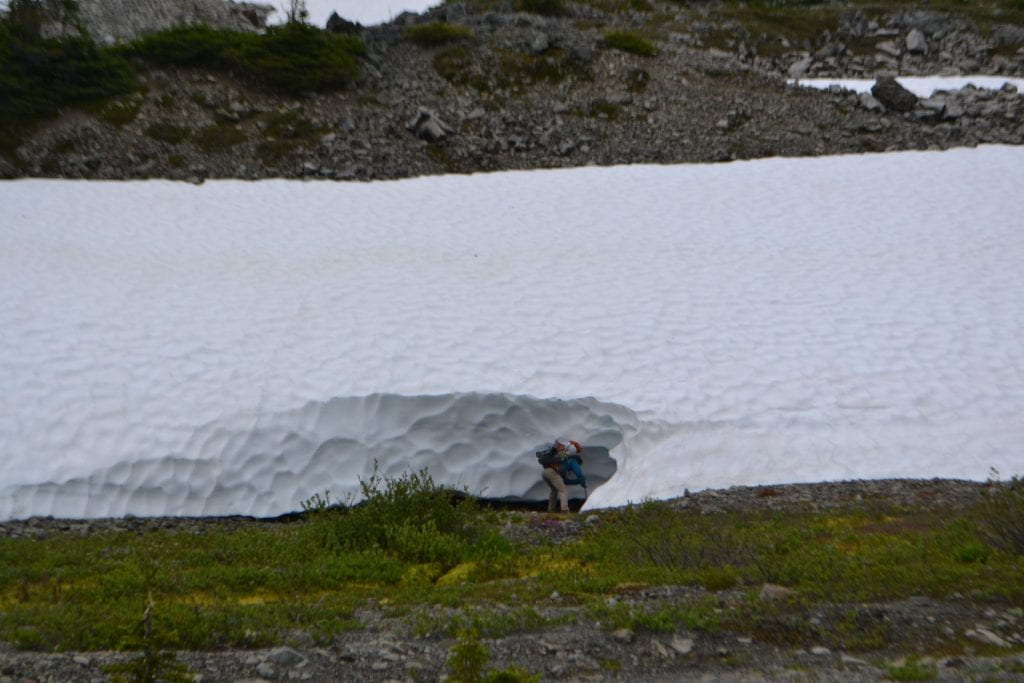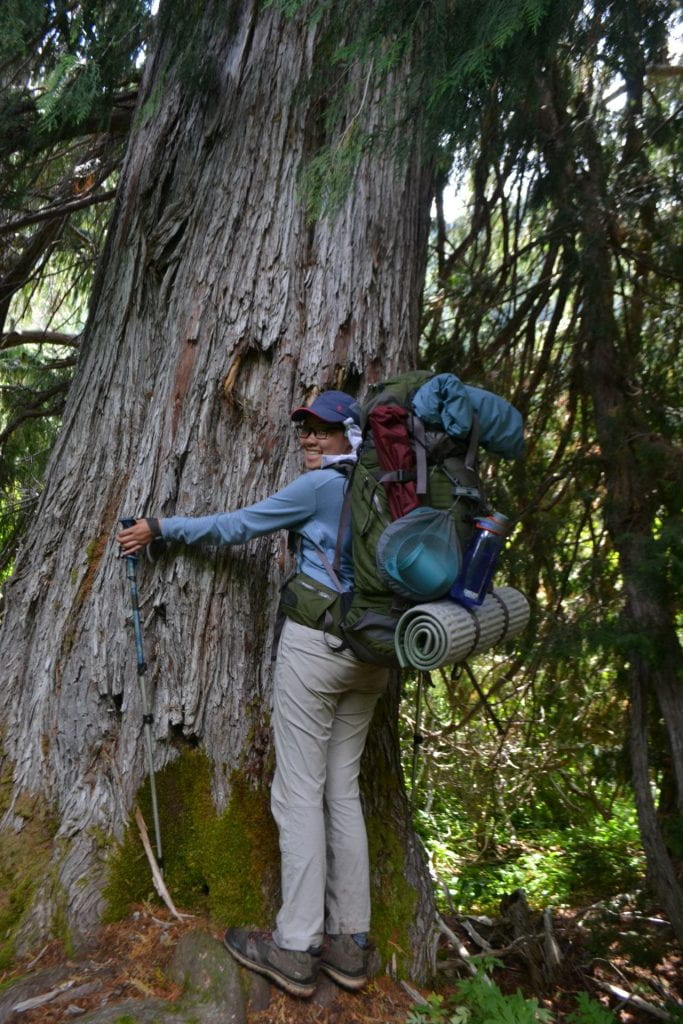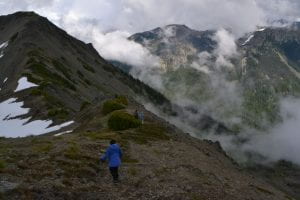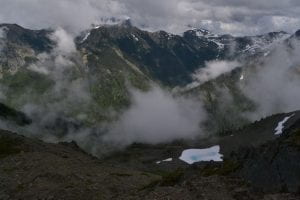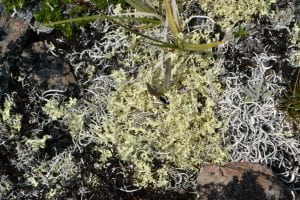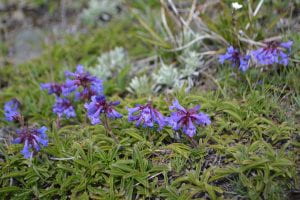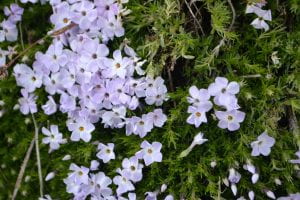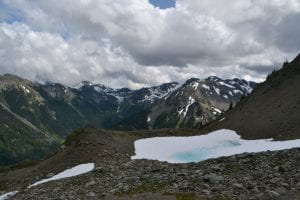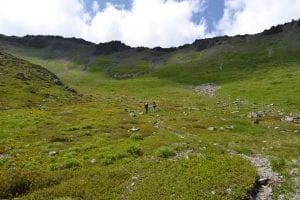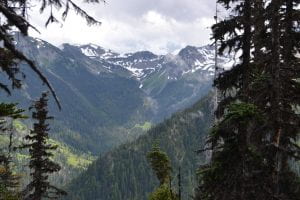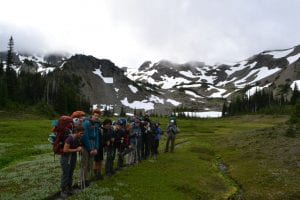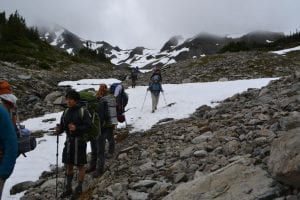Cameron Basin was a good hostess. After the rain we weathered briefly the previous night during Jonathon’s discussion, the clear star-studded skies had me worried about shivering through the night. Never have I jumped around so vigorously right before bed. That night was actually quite warm, though, and when I opened my eyes to Tim’s familiar, “time to get up” I felt rested, but reluctant to leave the delicious warmth of my sleeping bag. Fortunately, I was in a food group with Tim, so I think I tended to get away with sleeping a little longer than everyone else. Tim always got water for breakfast going before I even had my socks on, the early riser that he is. Shout out to Tim!
During a breakfast of what I remember to be oatmeal and almond butter, I asked Tim to rate the difficulty of the day ahead of us. The previous day had been, for me, quite a challenge; I was hoping for a slight respite today. I think Tim knew this… because he told me that today would be challenging, but that yesterday had been the worst of it. My confidence boosted, I enjoyed the company and antics of our group as I loaded up my pack for the day ahead. Hanna and Aisling, ever the jokesters, made an ice-ax safety video which cannot go unwatched–if anyone out there is reading this with the intention of taking this course, please consider Aisling’s pro tips to decide whether ENVIR 495 is the right challenge for you!
Despite the bugginess, the first half of our trip was such a pleasure. Meandering up and down little hills along a charming moss-bordered stream fed by the gently melting icepacks, and a bear casually roaming the meadows above, it was a pretty enough picture to put climate change out of my mind for a moment, although evidence of the threats to the global ecosystems as we know them were abundant in our views of the Olympics each day. Below is a picture I took as we left Cameron Basin, with the fabulous and determined Hanna Lester and Katie Keil bringing up the rear.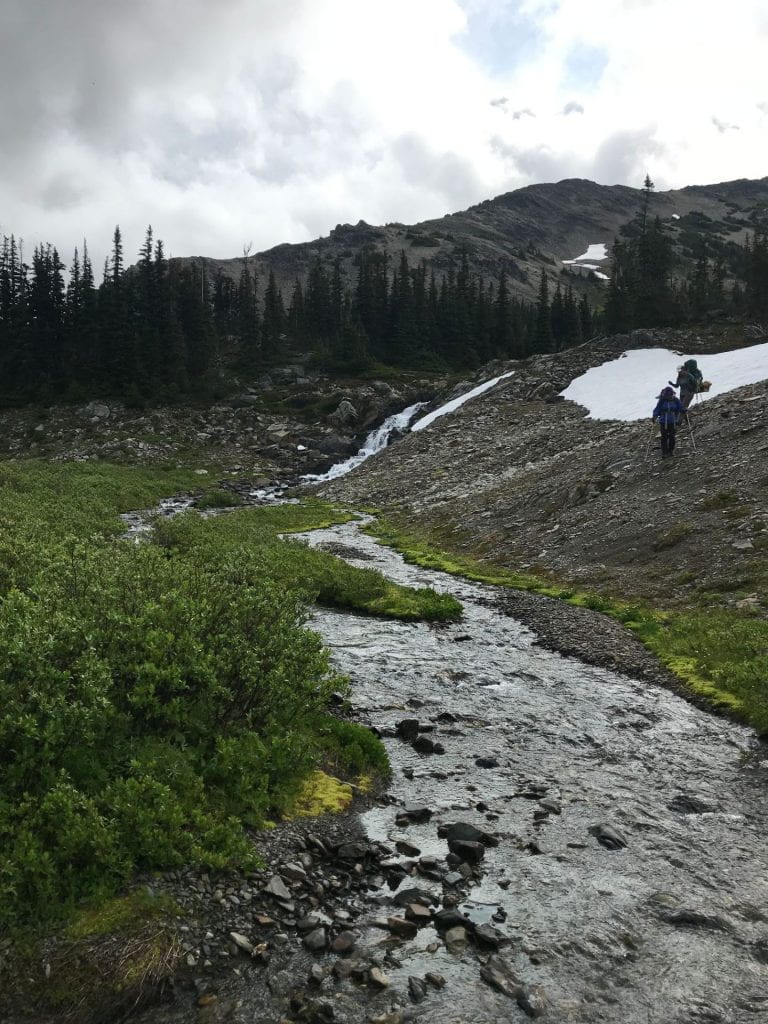
We stopped for lunch at a small campsite near the water. I should have taken Tim’s suggestion of a large lunch as a warning of what was to come… we combined two different kinds of thai noodles to make a giant pot of soup. We added peanut butter to the mix at Aisling’s suggestion, and it was *absolutely fantastic*.
About 10 minutes after lunch, we were back on the trail and the path began to steepen. With the skies clear for the first time since the rains began back on the second or third day of our hike, I was inwardly telling myself to be grateful for the sun, even as I began to sweat in my long sleeves. But we just kept going, and the path got steeper and steeper! I kept telling myself that this must only be a small section of the trail, that of course Tim wouldn’t LIE to me about how hard the day would be, but no… he still denies it, but I think he told us it would be easier so that we would stay hopeful through this toughest of hikes. And if that is the case, I am grateful. While my calves burned with the exertion, my appreciation for the majesty of the mountains burned deeper. I took this next picture perhaps 3/4 of the way up the trail. Our group had dispersed as the gung-ho athletes pulled ahead, and I took my time along with Amy Lin because I just couldn’t quite keep pace. But look how far up we were! The air was cool despite the warm sun, and the mists cleared more and more as we climbed higher. As tired as we were, Amy and I continued to find motivation in the reward of looking back down at all the elevation we had gained.
The wonderful thing about hiking in a group, especially the group we had, is the camaraderie. Amy and I could see up to the pass, where a few of the quickest of us had already stopped to wait, and they kept yelling and whooping encouragement as we trudged the last quarter of the way up. I can still conjure up that feeling, such sweet relief I felt when I finally reached the top of that pass and dropped my pack to the ground. And the views! I wish that everyone had the privilege that I had to take a whole week and see this beautiful place. When confronted with the mountains, right there in your face, and the plunging valleys rich in evergreens, and the stark white snowpacks contrasting brilliantly with the dark mountains, it’s easy to understand how the indigenous people of this place developed their religion around the land. I’m not embarrassed to admit that I was moved to tears multiple times during our time in the Olympics, but especially today. Not just because of the gorgeous surroundings–but because I couldn’t help thinking about the danger that this place is in. I think I see now, after this trip, why access to these places can help preserve the National Parks. I wonder where our solution to climate change lies… and in the conclusion of our journey, I’m starting to see that collaboration is key. It’s hard, coming from the native community, to approach environmental issues from a place other than anger and deep feelings of betrayal, which I think leads to a distaste for working together with residual colonial powers and people. But our little group is an excellent metaphor for this–we all came from different places, different families, with varied perspectives and skills. But we worked as one across the 50 miles of our journey, sharing the burdens and the joys. I wish the simplicity of our bond as a group could be translated to bringing communities together to protect this planet.
From the top of Grand Pass, we could see a snow patch beginning to melt into a brilliant blue lake. Once we had all reconvened at the top, Tim lead the way up to the summit of Grand Peak, where we came across a few beautiful mountain flowers, pictured below:
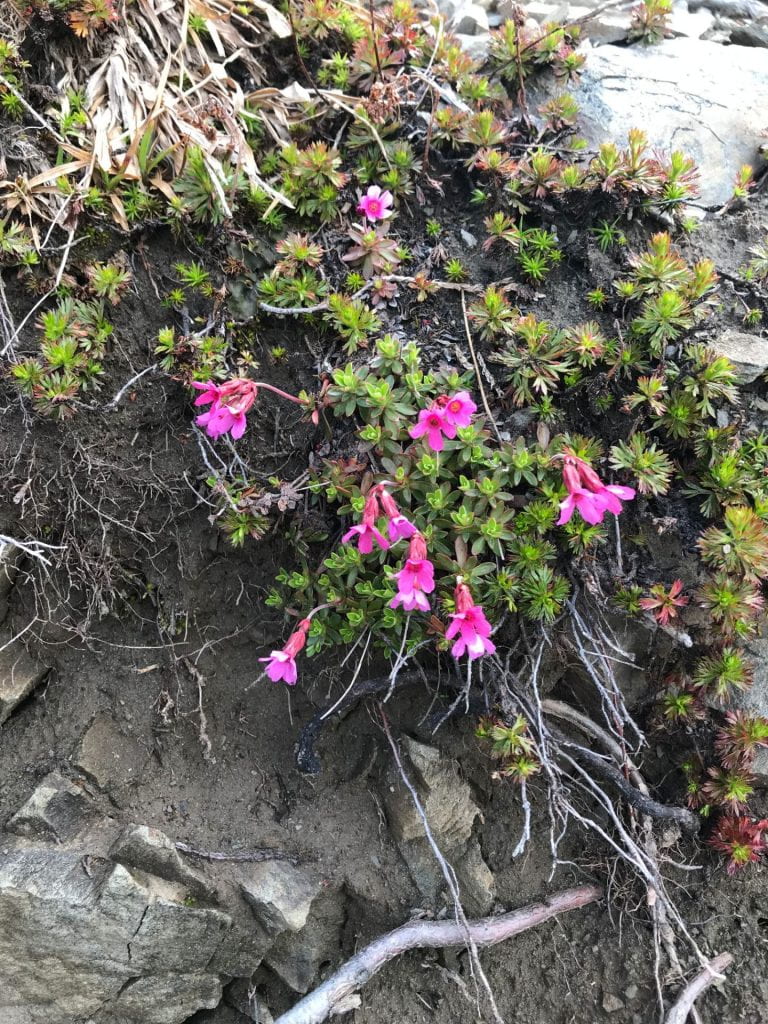
Douglasia flower. Small leaves and low profile reduce exposure and moisture loss to wind; large investment in roots; mat-forming growth which facilitates soil buildup and allows stems to protect each other; clusters of showy flowers to attract pollinators, such as hummingbirds, which can spot them from across the valley.
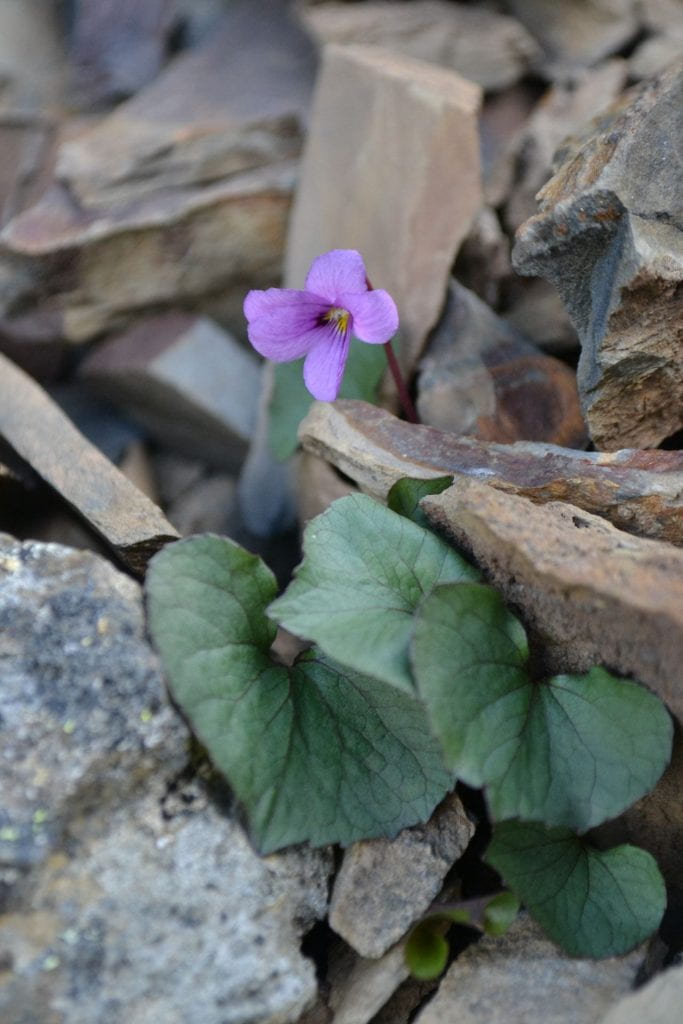
Flett’s violet on Grand Peak. This flower is endemic to the Olympic Mountains and grows on the highest ridges in the eastern part of the range. How will this species disperse to hospitable locations as climate continues to warm, assuming it already is growing in some of the coldest places in the range? And what will the National Park Service need to do about it if it becomes endangered? One of the quandaries posed by the Wilderness Act of 1964 is whether or not humans even should intervene with nature in “untrammeled” landscapes, although the Endangered Species Act would presumably take priority in this case. The solutions would be limited, however–would it be ethical, for example, to transplant the species into mountain ranges further north?
It was with excitement and surprising levels of energy that we donned our packs and began the trek down into Grand Valley. Hanna, ever determined and optimistic in spite of the knee injury, elected to slide down a snowpack rather than hike down the steep, and slightly treacherous trail. Tim loped across the ice effortlessly, reminding me of a bounding antelope as he gave quick lessons to Hanna and a few others on how to glissade (what a word!) safely. Katie S. and Z went first, and I nearly had a heart attack as I watched Z narrowly miss crashing into Katie, limbs and ice-ax flailing in the wind as he caught himself in the nick of time. My favorite was Hanna, though-she slid so slowly, holding the ice-ax in a death grip so hard that I could see her white knuckles from yards away, but the way she was screaming would have made you think she was going 100 miles an hour. The glee we all felt was infectious, and prolonged by our meeting with Sally Jewell, former Secretary of Interior and now one of my favorite people in the world. Bless her soul, she hiked all the way in to meet us with a giant bag of chips, guacamole, and cherries. The fresh fruit was heavenly, and we fell upon the spread like a swarm of flies on day-old roadkill. With cherry juice staining my lips, and my pack once again discarded off onto the path, I closed my eyes and took a moment to try to burn in my memory how appreciative I was feeling over something so simple… I see why people are so changed by experiencing wilderness in this way. It helps us connect to the animal in us, which is so satiated in modern life that we forget what a blessing something like fresh fruit is. Meeting Sally was by far one of the best parts of the trip. She was so welcoming and generous with her time. She took time to talk to each of us individually, and told stories about her achievements in the public and private sectors. It was refreshing, and inspiring, to be listened to by someone with as much experience as Sally. Her allyship and work with indigenous people across the United States gives me hope for a future administration that might take native people’s perspectives into consideration in the future of environmental conservation.

Hanna glissading down from Grand Pass.

Piper’s bell flower, one of the endemic species of the Olympic alpine zone, encountered just below Grand Pass. This species faces some of the same quandaries as the Flett’s violet. It has also been impacted by non-native mountain goats, although presumably the threat of goats will be permanently alleviated in the next few years.
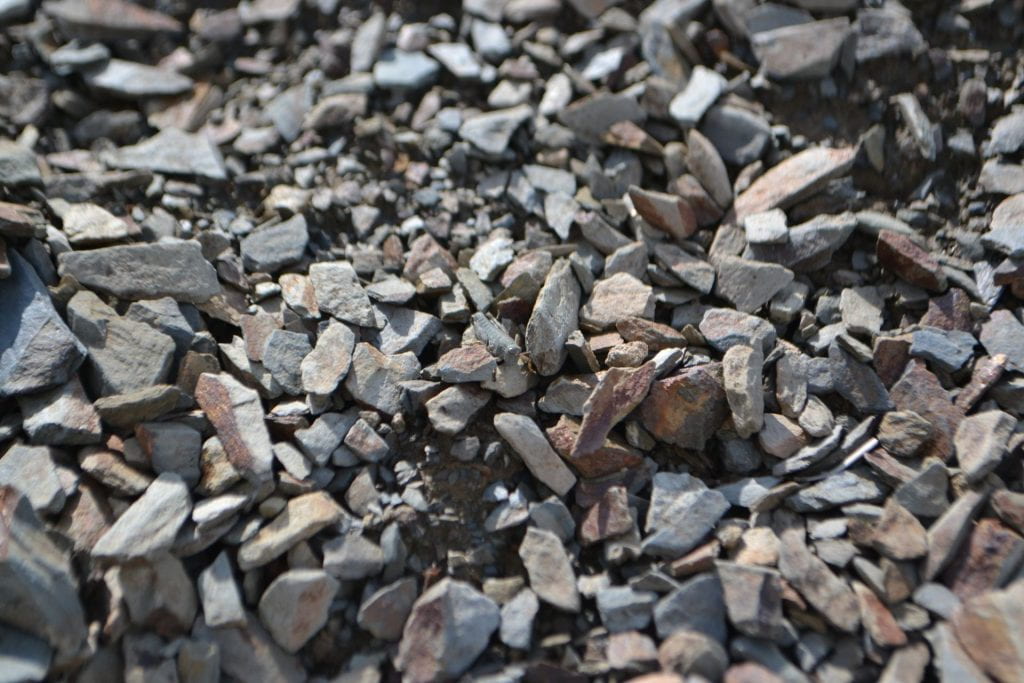
Can you spot the Olympic wingless grasshopper, encountered at Grand Pass, in this photo? This is one of the species endemic to the Olympics.

The group on top of Grand Peak. Skies are still moody, but we are stoked!

Hanna in her signature pose, having just conquered Grand Pass.
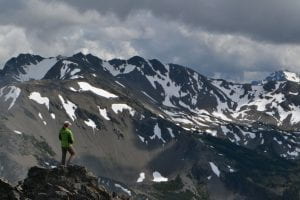
Wilderness TA, Katie, taking a look at the incredible terrain we had traveled that day.
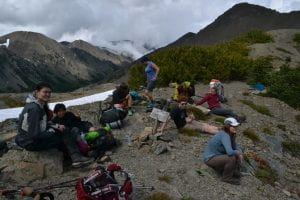
Taking a breather at Grand Pass
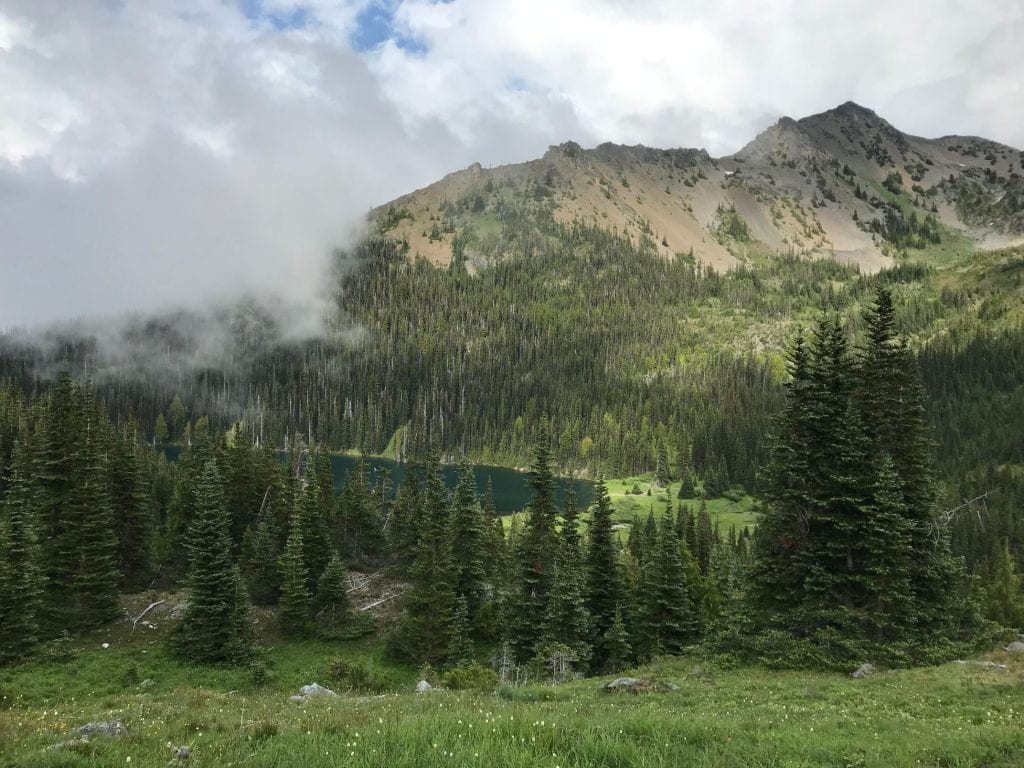
As we approached our campsite, Moose Lake came in to view. Huge, clear, surrounded by massive trees, it’s hard to believe the place was trashed by frequent camping in the 70’s. It’s a testament to the potential success of future restoration. The deer were bold and abundant down in the valley. They came closer and closer to us, seeking out our salty clothes.

1905 historical photo of Lillian Glacier from Grand Peak. Compare with the photo we too this year, from Grand Peak. To line up the two photos, look for the moraine, annotated in red in this photo, in the photo we took, shown below.

View of Lillian Glacier Valley from Grand Peak. You can line this up with the historical photo above.
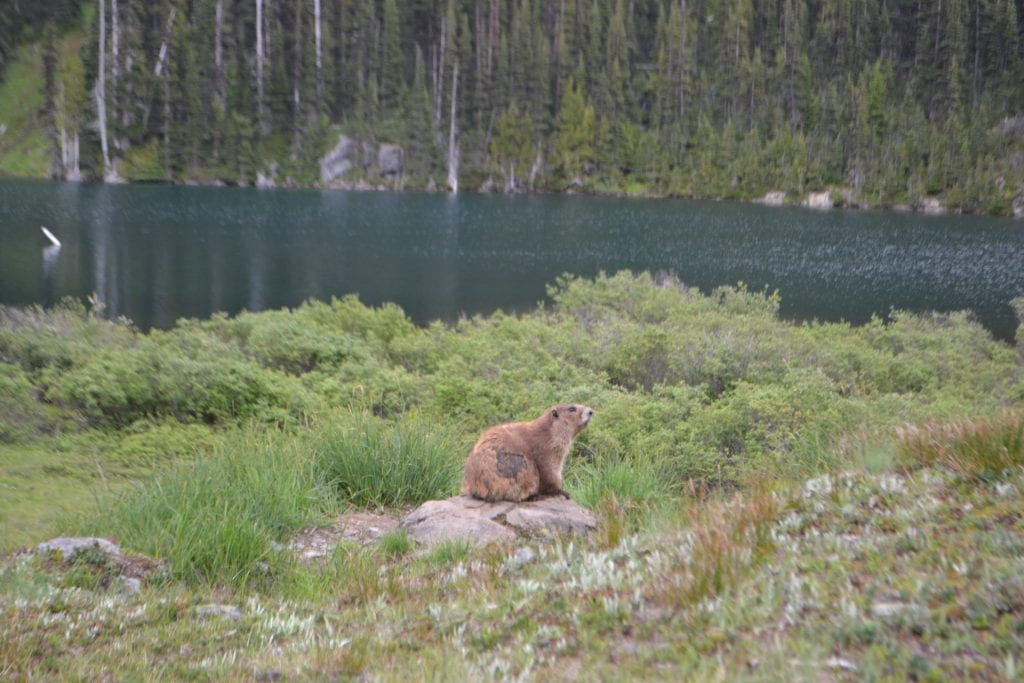
The Olympic Marmot is still abundant in Grand Valley, but closer to the edges of the mountain range, it is threatened by encroaching coyotes. Coyotes, while native, would have been historically suppressed by the now extinct Gray Wolf.

The somewhat uncommon (in the Olympic alpine zone) western spring beauty, found on the way up Grand Pass.
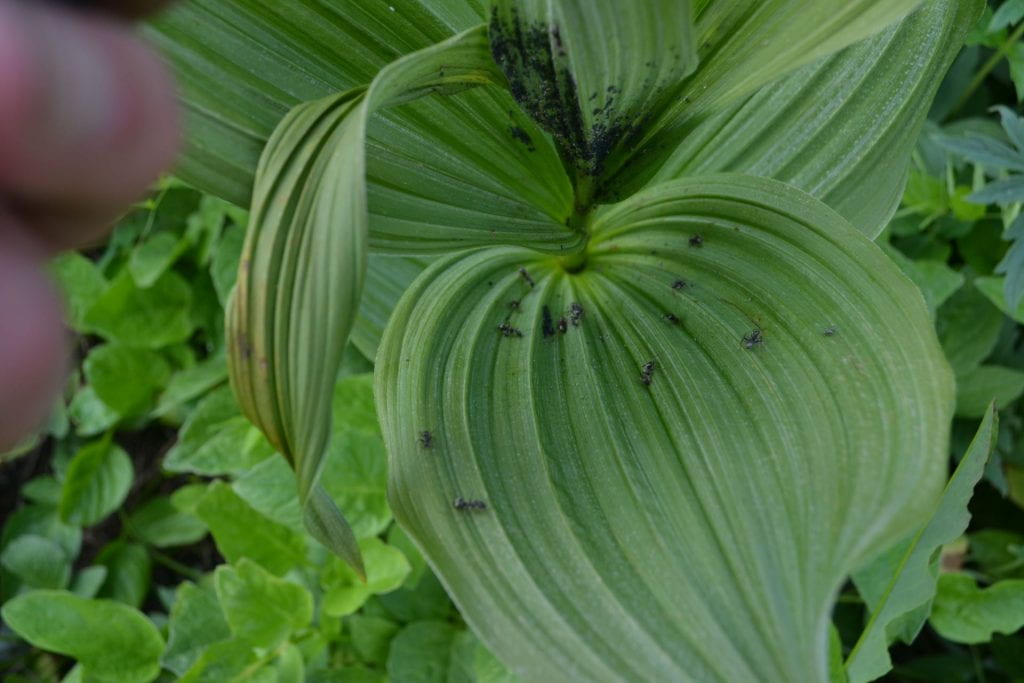
Ants tending aphids on the cornstalk lily. We saw this interaction on the cornstalk lily several times throughout the trip.
